Bedford School
Bedford School is a public school (English fee-charging boarding and day school for boys) in the county town of Bedford in England. Founded in 1552, it is the oldest of four independent schools in Bedford run by the Harpur Trust.
| Bedford School | |
|---|---|
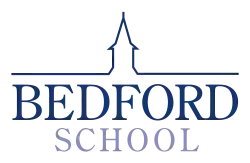 | |
| Address | |
De Parys Avenue , England | |
| Information | |
| Type | Public School Private day and boarding |
| Motto | Floreat Schola Bedfordiensis (May Bedford School Flourish) |
| Religious affiliation(s) | Church of England |
| Established | 1552 |
| Founder | Edward VI |
| Department for Education URN | 109718 Tables |
| Headmaster | James Hodgson |
| Gender | Boys |
| Age | 7 to 18 |
| Colour(s) | Navy and white |
| Publication | The Ousel |
| Former pupils | Old Bedfordians |
| Boat Club | Bedford School Boat Club |
| Website | www |
Bedford School is composed of the Preparatory School (ages 7 to 13) and the Upper School (ages 13 to 18). There are around 1,100 pupils, of whom approximately one half are boarders. In 2014, James Hodgson succeeded John Moule as headmaster after Moule moved on to Radley College.
The school has produced one Nobel Prize winner, five recipients of the Victoria Cross, twenty-four rugby internationals, the winners of eight Olympic gold medals, and a former England cricket captain, Alastair Cook.
History
Background
Although no large scale educational institution had existed in Bedford before the foundation of Bedford School, the collegiate St Paul's Church had run systems to teach Bedford's youth Latin and church history since at least 1086. This was overseen by Bedford's archdeacon, but this ceased when the church's monks became canons regular, moving to Newnham Priory; until the priory's dissolution in 1540, education in Bedford continued elsewhere in the town. This medieval school, located on "Scolestreet", later Mill Lane, had ended by 1447.[1]
Foundation and early years
On 15 August 1552, Edward VI issued letters patent in Ely allowing the "Mayors, Bailiffs, Burgesses and Commonality of Bedford" to establish a grammar school in the town. The letters instructed boys to be taught by a Master and Usher chosen by the Warden and Fellows of New College, Oxford;[2] Bedford's first headmaster was Edmund Greene, a Fellow of the College who had been teaching in Bedford for four years before the establishment of the school – Greene's relationship to the College was the reason for it's appointment to choose the school's leadership.[1]
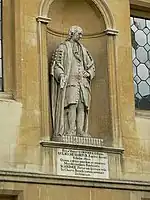
In the same year, William Harpur, likely an alumnus of the early school on Mill Lane, donated a building to the school, and in 1566 deeded several parcels of meadow around Bedford and Holborn to the school to insure it an income.[3] After a decline in school size following widespread miduse of corporal punishment – a student almost died after being attacked by the school's usher – Bedford began boarding in 1656 under the headmastership of George Butler, expanding the school, although boarding ended by 1660.[4] However, the school grew little over the next century and a half[5] (in 1747, the school had 11 pupils),[6] due to incompent headmasters and a lack of funding; it also grew little in social standing as compared to schools such as Winchester, Westminster, or Eton, although tihs can be partially attributed to its location in Bedford and lack of architecturally attractive estate.[5]
In 1764, the Harpur Trust was formally created by Act of Parliament to administer Bedford School's endowment.[7] After the Great Fire of London, much of Harpur's land in London was build on, and so by 1900, the Harpur Trust was receiving payments from these of around £14,000 (equivalent to £1,611,524 in 2021) per year.[8] Following its foundation, Bedford School expanded greatly, increasing its head count and restoring its buildings.[7] The "Writing School", now Bedford Modern School, also split to form a separate grammar school.[9]
Late modern period
Around 1810, headmaster John Brereton restarted boarding at Bedford, although the school still primarily taught day students. By 1820, Bedford had 84 students, of which half were boarders.[10] During Brereton's tenure, Bedford took on many characteristics of Victorian public schools, including fagging, and compulsory Christianity. The school's curriculum was broadened, and modernised the school,[11] for example by implementing better living conditions for boys[12] and installing gas.
Buildings and grounds
Main School Building
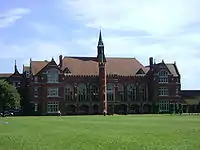
The Main School Building, originally built in 1891, is a Gothic Revival Grade II listed building.[13][14] On the night of 3–4 March 1979, much of the building was gutted by fire as a result of arson. The internal structure of the building was destroyed and thirty classrooms were lost. Almost all pupil records were saved but books, furniture and the large collection of portraits of former headmasters were lost. However, the school was in full operation on Monday 5 March.[15][16]
The integral structure of the walls was not affected by the fire, and under the indefatigable leadership of the headmaster, Ian Jones, and two Chairmen of the Harpur Trust, John Howard and Anthony Abrahams, the building was restored within two years. The architect, Philip Dowson, made a number of alterations to the building during the restoration process: the most important was the raising of the central Great Hall to first floor level in order to provide more classroom and administrative space on the ground floor below.[13]
Chapel
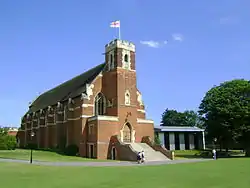
Bedford School Chapel was completed in 1908 and is a Grade II* listed building. It is significant as the last architectural accomplishment of George Frederick Bodley, a prominent Victorian architect who worked in the Gothic Revival style. Other notable buildings by Bodley include the chapels of Marlborough College and Queens' College, Cambridge.[17]
In 2005, various refurbishment projects took place within the chapel. Most significantly, the ceiling was restored to its former Bodlian watercolour design, the original having been painted over in the 1960s due to deterioration. At the same time, the interior walls were redecorated and the stonework cleaned.
The chapel is home to Bedford School's chapel choir and houses a fine two-manual Hill, Norman & Beard organ. The specification of this instrument can be found in the National Pipe Organ Register.
Observatory and planetarium
The Charles Piazzi Smyth Observatory and the Wolfson Planetarium were opened in May 2002 by Prince Philip, Duke of Edinburgh. Situated on the Bedford School estate, the facility is operated by the school's astronomer in conjunction with members of the Bedford Astronomical Society.[18]
The observatory was named after an Old Bedfordian who went on to become the Astronomer Royal for Scotland. It boasts a custom-designed GRP dome and a computer-controlled twelve-inch (305mm) telescope. The telescope has a hydrogen alpha filter, which enables the observer to view the magnetic plasma flow around the sun. The adjacent Planetarium was named after the Wolfson Foundation.
Music school
Bedford School Music Department is housed in the new purpose-built Music School, designed by Eric Parry, and completed in November 2005. The building houses a large recital hall with recording facilities, a recording studio, individual specialised teaching and practice rooms, and a rock music studio. The building was officially opened by Peter Maxwell Davies, Master of the Queen's Music, in March 2006, and the recording facilities were officially opened by David Arnold on 20 May 2013.[19]
Cricket ground
The first recorded match on the Bedford School cricket ground was played in 1876, between Bedfordshire and Huntingdonshire.[20] Bedfordshire played its first Minor Counties Championship match on the ground in 1895, against Hertfordshire. Since 1895, the ground has been host to 181 Minor Counties Championship matches.[21] In addition, the ground has been host to five MCCA Knockout Trophy matches for Bedfordshire, the first played in 1993 between Bedfordshire and Cambridgeshire.[22]
The ground has been host to two List-A matches for Northamptonshire: the first was played in the 1971 John Player League, between Northamptonshire and Lancashire; and the second was played in 1982, in the same competition and between the same two sides.[23] It has also been host to twenty-five Second XI fixtures for the Northamptonshire Second XI in the Second XI Championship for the Second XI Trophy.[24][25]
Academic
Structure
The first year at Bedford School (for 13- to 14-year-olds) is called the Fourth Form and is equivalent to Year 9 in the state system. After that come the Remove and the Fifth Form. The next two years are the Lower Sixth and the Upper Sixth. Bedford School also caters for the lower years (from Year 3 to Year 8) in Bedford Preparatory School. This is located on the Bedford School estate and many facilities are shared.
| Year Group | State school equivalent | IB | A-Level |
|---|---|---|---|
| Fourth Form | Year 9 | - | - |
| Remove | Year 10 | - | - |
| Fifth Form | Year 11 | - | - |
| Lower Sixth | Year 12 | IB1 | AS |
| Upper Sixth | Year 13 | IB2 | A2 |
House system
Bedford School has six houses. Each house is composed of a day house and an associated boarding house. The day houses are areas for students to relax during breaks from teaching whilst the boarding houses are for students to reside in. The house names, dating from the mid-nineteenth century, refer to areas of Bedford; boys were originally allocated a house based on the area of town in which they lived. Whilst these are the official house names, it is common for boarders to refer to their house by the name of their boarding house.[26] The houses are:
Ashburnham – The day house occupies a large building adjacent to the Design and Technology Building. The boarding house, Sandersons, known informally to students as ('Sandies'), is situated within a ten-minute walk of the school in Rothsay Gardens, adjacent to Redburn. The house colours are dark red and brown.
Bromham – The day house is situated on Burnaby Road at the main entrance to the school, next to the Rice Building. The school's sixth form boarding house, Burnaby, is situated on Burnaby Road. The house colours are light blue and navy blue.
Crescent – The day house is situated in a two-storey building towards the south of the school estate. The boarding house, Pemberley, is situated on Pemberley Avenue. The house colours are black and white. The name Crescent derives from The Crescent, a road to the north-east of Bedford town centre running between Bromham Road and Tavistock Street.
Paulo Pontine – The day house occupies a single storey ground floor area beneath the Art Department towards the south of the school estate. The boarding house, Redburn, is situated within a ten-minute walk of the school. The house colours are gold, brown and light blue. The house takes its name from the area around St Paul's Church ('Paulo') and the area south of the river, over the Town Bridge ('Pontine').
St Cuthbert's – The day house is located next door to the Medical Centre on Burnaby Road. The boarding house, Phillpotts, is situated in the north-east corner of the school estate. The house colours are dark blue and black.
St Peter's – The day house occupies a purpose-built building next to its boarding house, Talbots, on Burnaby Road. The house colours are scarlet (formerly cerise) and white.
School officials
Bedford School monitors are selected from amongst the boys of the Upper Sixth. They are entitled to wear coloured waistcoats and brown shoes as well as brass buttons on their blazers.[27] The head of school and the deputy head are selected from amongst the monitors.
Colour system
Bedford School recognises individual achievement in various fields by the awarding of 'colours', at the discretion of the appropriate master, to boys in the Fifth Form and above. The various colours entitle the bearer to wear a particular variant of his uniform, appropriate to that award, on given days. There are five types of colours: Academic, Arts, Headmaster's, House, and Sports (Major and Minor).[28]
Extracurricular activities
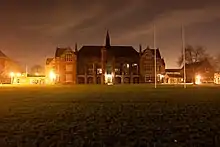
Chapel Choir
The Chapel Choir sings the weekly and special services in Bedford School Chapel.[29] The choir consists of eighteen choristers from the Preparatory School and twenty-four choral scholars from the Upper School, many of whom are former cathedral choristers.
The Chapel Choir regularly sings services and performs concerts in English cathedrals, including St Paul's Cathedral and Westminster Abbey. The choir also tours abroad in alternate years. Previous destinations have included: Prague (1998); Oslo (2000); Paris (2002), where the choir sang mass in Notre Dame Cathedral; Rome (2004), where the choir sang mass in St. Peter's Basilica; Ireland (2006); Madrid (2008), and Belgium (2019) .[29]
The choir has made several recordings in recent years. In 2007, the BBC recorded the school's Festival of Nine Lessons and Carols for transmission on Christmas Day of that year on BBC Radio under the direction of Andrew Morris, Director of Music at Bedford School between 1979 and 2011.They also recorded A CD entitled "A Bedford Christmas" in 2018.[30]
School magazines
Bedford School produces several magazines, of which the most prominent is The Ousel, published regularly since 1876.[31] It is largely written by boys and managed directly by the school. It is published at the end of each Summer term and contains pupil and staff reviews of the school year. The school's Mosaic Society runs the Mosaic magazine which contains a range of essays and articles written by boys on subjects ranging from current affairs and politics to sport and science.[32] In 2011, the Classical Society introduced its new publication, VIM Magazine. Run entirely by the boys, with support provided by members of staff from the Classics Department, the magazine contains academic essays as well as more light-hearted articles on classical fashion and travel. It bears testament to the burgeoning resurgence of Classics at Bedford School.
Sport
Bedford School has a different major sport for each term. The Christmas term is rugby union orientated, the Easter term is devoted to hockey, and Summer is the cricket season. Rowing with the Bedford School Boat Club takes place on the River Ouse throughout the year. Other popular Bedford School sports include athletics, badminton, basketball, canoeing, cross-country running, fencing, fives, football, golf, rifle shooting, sailing, squash, swimming, table tennis, tennis, volleyball, water polo and weight training.[33]
The school has produced many sportsmen, including cricketer Alastair Cook,[34] who went on to captain the England cricket team, and whose coach at Bedford School was sports master and former England batsman Derek Randall. Other famous Bedford School sportsmen include England rugby internationals Martin Bayfield and Andy Gomarsall; the rower Jack Beresford, winner of five Olympic medals; and 1924 Olympic 100-metre sprint gold medalist Harold Abrahams.
Headmasters
Edmund Greene was appointed as headmaster of Bedford School prior to Bedford School's foundation in 1552. From then on the Wardens and Fellows of New College, Oxford were given the right to appoint the master (headmaster) and usher (deputy headmaster).[35] This came to an end in 1903, with the appointment of John Edward King to headship. The schools headmasters have been:[36]
- 1548 Edmund Greene
- 1573 William Smyth
- 1577 Francis White
- 1587 Master Chambers
- 1597 Richard Butcher
- c1599 Henry Whitaker
- 1601 Robert Barker
- 1610 Daniel Gardener
- 1636 William Varney
- 1656 George Butler
- 1660 William Varney
- 1663 John Allanson
- 1665 John Butler
- 1672 John Longworth
- 1681 William Willis
- 1683 Nicholas Aspinall
- 1718 Matthew Priaulx
- 1739 George Bridle
- 1773 John Hooke
- 1810 William Stratford
- 1811 John Brereton
- 1855 Frederick Fanshawe
- 1874 James Surtees Phillpotts
- 1903 John Edward King
- 1910 Reginald Carter
- 1928 Humfrey Grose-Hodge
- 1951 Clarence Seaman
- 1955 William Brown
- 1975 Ian Jones
- 1986 Sidney Miller
- 1988 Michael Barlen
- 1990 Philip Evans
- 2008 John Moule[37]
- 2014 James Hodgson[38]
Notable staff
- Charles Abbot (1761–1817), Fellow of New College, Oxford, botanist and entomologist, Usher at Bedford School, 1787–1817[39]
- Robert Steele (1860–1944), Medievalist
- W. H. D. Rouse (1863–1950), Fellow in Classics at Christ's College, Cambridge[40]
- Stanley Toyne (1881–1962), Historian, Hampshire and MCC cricketer
- Jack Hobbs (1882–1963), Surrey and England cricketer
- Rex Alston (1901–1994), a master at Bedford School, 1924–1941, before becoming a BBC sports commentator[41]
- Evelyn King (1907–1994), Labour MP, 1945–1950, Conservative MP, 1964–1979
- John Durnford-Slater (1909–1972), raised the first Commando unit in 1940, Estate Bursar and Commanding Officer of the CCF at Bedford School
- William Ronald Dalzell (1910–2004), book illustrator, author, and lecturer on the arts; art master, 1947-70[42]
- Godfrey Brown (1915–1995), History master, Olympic gold medal winner, 1936
- Mary Midgley (1919–2018), moral philosopher
- Jack Bailey (1930–2018), Essex and MCC cricketer, Secretary of the MCC, 1974–1987
- Bernie Cotton (born 1948), Olympic hockey player, 1972, manager of the Great Britain Olympic hockey team, 1992
- Andrew Morris (born 1948), conductor and organist, Director of Music at Bedford School, 1979–2011
- Derek Randall (born 1951), Nottinghamshire and England cricketer
- Gary Steer (born 1970) Derbyshire County Cricket Club
Alumni
See also
Notes
- De-la-Noy 1999, p. 3.
- De-la-Noy 1999, p. 1.
- De-la-Noy 1999, p. 5.
- De-la-Noy 1999, pp. 8–9.
- De-la-Noy 1999, pp. 10–11.
- De-la-Noy 1999, p. 14.
- De-la-Noy 1999, p. 15.
- De-la-Noy 1999, p. 6.
- Davis, Robin (1967). The Grammar School. Penguin Books. p. 34 – via Internet Archive.
- De-la-Noy 1999, p. 19.
- De-la-Noy 1999, p. 21.
- De-la-Noy 1999, p. 23.
- Barlen, M E: Bedford School and the Great Fire (London: Quiller Press, 1984) p.86
- Historic England. "Details from listed building database (1137959)". National Heritage List for England. Retrieved 15 August 2012.
- "www.bedfordschool.org.uk 25th Anniversary of Bedford School's Great Fire, March 2004". Bedfordschool.org.uk. Archived from the original on 18 February 2011. Retrieved 2012-08-15.
- "www.bedfordschool.org.uk An interview with Mr Simms, who celebrated 50 years with Bedford School this week, November 2009". Bedfordschool.org.uk. Archived from the original on 19 July 2012. Retrieved 15 August 2012.
- Historic England. "Details from listed building database (1321037)". National Heritage List for England. Retrieved 15 August 2012.
- De-la-Noy, p.221
- "An introduction to Bedford School Music School". Bedford School. 20 September 2011. Archived from the original on 27 July 2012. Retrieved 15 August 2012.
- "Other matches played on Bedford School Ground". Cricketarchive.com. Retrieved 15 August 2012.
- "Minor Counties Championship Matches played on Bedford School Ground". Cricketarchive.com. Retrieved 15 August 2012.
- "Minor Counties Trophy Matches played on Bedford School Ground". Cricketarchive.com. Retrieved 15 August 2012.
- "List-A Matches played on Bedford School Ground". Cricketarchive.com. Retrieved 15 August 2012.
- "Second XI Championship Matches played on Bedford School Ground". Cricketarchive.com. Retrieved 15 August 2012.
- "Second XI Trophy Matches played on Bedford School Ground". Cricketarchive.com. Retrieved 15 August 2012.
- De-la-Noy, p.123
- De-la-Noy, p.56
- Awards & Achievements
- "Bedford School". Bedford School. Archived from the original on 3 April 2011. Retrieved 15 August 2012.
- De-la-Noy, p.218
- De-la-Noy, p.52
- De-la-Noy, pp.116–117
- De-la-Noy 1999, pp. 197–198.
- Randall, Charles (16 April 2008). "Alastair Cook reprises his original hits". London: The Daily Telegraph. Retrieved 3 March 2009.
- F.A.M. Webster, Our Great Public Schools, 1937.
- De-la-Noy 1999, p. 225.
- "Moule, John Stuart, (born 29 May 1971), Warden, Radley College, since 2014". WHO'S WHO & WHO WAS WHO. doi:10.1093/ww/9780199540884.013.u257808. Retrieved 25 October 2023.
- "Bedford School: Winners of Independent Boys' School of the Year 2021". Independent School Parent. 25 February 2022. ISSN 0307-1235. Retrieved 25 October 2023.
- Slatter, Enid (2010) [2004]. "Abbot, Charles". Oxford Dictionary of National Biography (online ed.). Oxford University Press. doi:10.1093/ref:odnb/2. (Subscription or UK public library membership required.)
- Who's Who
- Baxter, Peter (2 June 2003). "BBC SPORT | Cricket | Test Match Special | Legends | Rex Alston". BBC News. Retrieved 3 February 2014.
- Cover notes. The Shell guide to the history of London. Book Club Associates, London, 1981.
References
- Barlen, M. E.; Stambach, M.P.; Stileman, D.P.C. (1984). Bedford School and the Great Fire. Quiller Press. ISBN 0-907621-37-6.
- De-la-Noy, Michael (1999). Bedford School: A History. Bedford School. ISBN 0-9536685-0-9.
- Godber, Joyce (1973). The Harpur Trust 1552–1973. White Crescent Press Ltd. ISBN 0-9502917-0-6.
- Sargeaunt, John & Hockliffe, Ernest (1925). A History of Bedford School. T. Fisher Unwin.